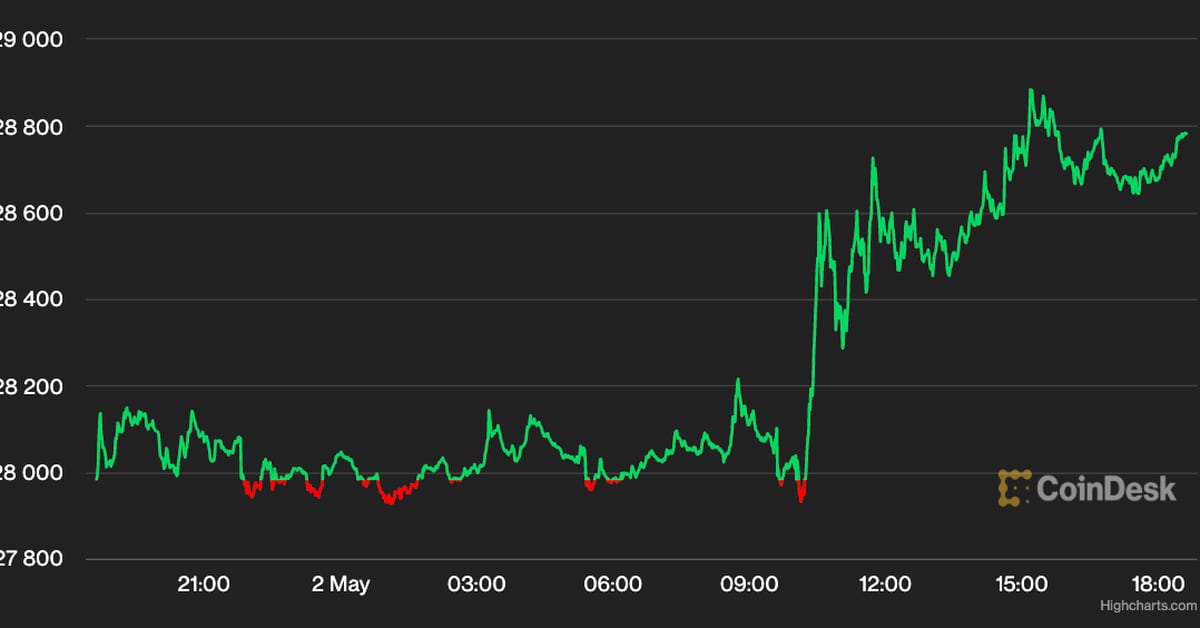An important step in bringing regulatory clarity to Bitcoin, Stablecoins and digital assets

Senator Cynthia Lummis, a Republican from Wyoming, on the left, will speak at the DC Blockchain Summit in Washington, DC, USA, on Tuesday, May 24, 2022, with Kirsten Gillibrand, Democratic Senator from New York. Photographer: Valerie Pleasch / Bloomberg
© 2022 Bloomberg Finance LP
Last month, Wyoming Senator Cynthia Lummis and New York Senator Kirsten Gillibrand unveiled their long-awaited bill for two parties to build a federal regulatory framework for cryptocurrencies such as Bitcoin. If the bill, called the “Responsible Financial Innovation Act”, were to become law, the United States could immediately outperform its competitors and become a world leader in crypto-innovation and inclusion. Here’s why.
How regulatory clarity can strengthen innovation
A common staple in public policy debates is that too much regulation will stifle innovation, by reducing the opportunities for entrepreneurs and businesses to come up with new ways to solve old problems. This is true. But uncertain regulations are just as bad, because it is difficult for companies to invest huge sums of time, effort and capital in companies that the government later decides are illegal.
The US regulatory environment for crypto has been exceptionally poor, operating many of the most innovative companies offshore. A large part of the problem has been that US financial markets are regulated by several independent agencies whose jurisdiction overlaps: in particular the Securities and Exchange Commission (SEC), the Commodity Futures Trading Commission (CFTC), the US Treasury Department and the US Federal Reserve. In other countries, these regulatory functions are under a single agency, making it easier to propose consistent regulations for new asset classes.
Under both the Biden and Trump administrations, the SEC has been known for its aggressive but unpredictable behavior toward cryptocurrencies. In September last year, for example, the SEC told Coinbase to end its efforts to offer interest payments to its customers, claiming that such interest payments were “securities”. In a long blog post, Coinbase Chief Legal Officer Paul Grewal expressed frustration that Coinbase’s attempts to preventively share their product design with the SEC were to no avail. “The SEC will still not explain why they see a problem,” Grewal wrote. “Rather, they have now told us that if we launch [the interest payment service] they intend to sue. Once again, we asked if the SEC would share their reasoning with us, and once again they refused. “
The SEC’s approach to cryptocurrency regulation has simply been to say that projects must follow Howey test, a vague standard based on a 1946 Supreme Court case called SEC v. WJ Howey Co.. Because so much of the crypto-innovation transcends 1930s securities legislation, and because the SEC has refused to provide clear guidelines on its approach to cryptocurrencies, many entrepreneurs who operate in good faith have no idea they will wake up one day and discover that the SEC wants to close them.
The law on responsible financial innovation would solve many of these problems by creating clear legal definitions and regulatory fields for digital assets. Let’s take a look at the bill to see how.
A big win for the CFTC
Lummis-Gillibrand effectively divides the digital asset world into three buckets: commodities, securities and “related assets”. The bill actually defines digital aids as cryptocurrencies which, although fluctuating in value, do not give the holder a “profit or income share” or “other financial interest” such as “debt or equity” in the company issuing the tokens. On the other hand, traditional listed shares offer ownership interests in issuing companies.
More importantly, under Section 301 of the Bill, issuers of these additional funds will be required to provide certain information to the SEC. By complying with these disclosure requirements, digital assets should be “assumed to be a commodity”, and therefore under CFTC regulation. Section 403 explicitly provides CFTC “exclusive jurisdiction over any … digital asset … including ancillary assets” other than shares or debt securities.
These provisions would end the chaotic grass war between the SEC and other federal agencies. Crypto projects want to know which regulations to follow and which regulators to engage with. In turn, this will open the door to huge financial innovation for American consumers, who are currently barred from participating in many digital asset innovations because projects do not want to deal with the SEC’s unpredictability.
At the same time, projects that want to enter the US market will need to provide meaningful revelations about their businesses, their financial condition and their plan to protect consumers in the event of bankruptcy. This openness will weed out fly-by-night crypto projects, and reward them with genuine financial benefit.
Bringing the dollar into the 21st century
Lummis-Gillibrand is making a significant effort to create a regulatory structure around “stablecoins”, digital assets denominated in US dollars or another traditional, state-issued “fiat” currency. The Stablecoin regulation has gained extra importance in the wake of the collapse of the algorithmic stablecoin TerraUSD, in which the sponsor of TerraUSD issued tokens that it claimed were worth $ 1, but which were not fully supported, or Safetywith cash or equivalent.
Done right, stablecoins are basically the 21st century version of money market funds, an asset class of $ 4.5 trillion of mutual funds whose value is pegged to the US dollar. Stablecoins fully supported by cash, government bonds and other cash-like instruments have proven to be very useful in bridging the gap between conventional and digital asset transactions.
Section 601 of the Responsible Financial Innovation Act establishes a structure for regulated stable coins, whose sponsors “shall maintain high quality liquid assets … equal to not less than 100 per cent of face value” of the value of the stable coins issued, with “high “quality” defined as US currency, government bonds, Federal Reserve balances and other well-established cash-like instruments.
By establishing clear rules for regulated stack coins, Lummis-Gillibrand is becoming obsolete by the Federal Reserve’s dangerous push for a China-style digital central bank currency. Stablecoin sponsors, such as Circle and Coinbase’s USD Coin, are able to provide all the benefits of a blockchain-based dollar while limiting government access to total monitoring of US regular transactions.
A proper “sandbox”
A very constructive provision in the law on responsible financial innovation will enable states to establish “financial regulatory sandboxes” where crypto projects can operate for a maximum of two years, without the risk of being closed by regulators (as long as the project complies with basic consumer protection).
The “sandbox” idea was developed by SEC Commissioner Hester Peirce, who in 2020 proposed establishing a safe haven for three years for new crypto projects. “We’ve made a regulatory Catch-22,” Pierce observed. Wild networks cannot get tokens into people’s hands because their tokens are potentially subject to securities laws. However, potential networks cannot mature into a functional or decentralized network that does not depend on a single person or group to perform the essential managerial or entrepreneurial efforts. “unless the tokens are distributed to and freely transferred between potential users, developers and participants of the network. The securities laws can not be ignored, but we as securities regulators can not ignore the mystery our laws create.”
Pierce’s three-year safe haven seems more sensible than Lummis-Gillibrand’s two-year-old, given the time frame needed to build a new network. Fortunately, this is the kind of thing that is easy to fix, should the bill continue to move forward in Congress.
Areas for improvement
As I recently discussed with Peter McCormack, the most important missed opportunity in the Lummis-Gillibrand Bill is its inability to reduce the risk of the Federal Reserve creating a digital central bank currency. As I mentioned above, China has enthusiastically embraced the idea of a cryptocurrency version of the yuan, because a transition from paper cash to a state-controlled digital currency will enable Beijing to monitor and censor its economic activity.
At this point, the US Federal Reserve CBDC is curious: neither for nor against. In a January 2022 White Paper, the Fed described what it sees as both the risks and benefits of a CBDC, but argued that the paper “is not intended to promote any specific political outcome.” To protect American civil liberties, Lummis-Gillbrand should make it clear that the Fed does not have the legal mandate to establish a CBDC without the explicit consent of Congress.
Will Lummis-Gillibrand ever be allowed?
If Lummis-Gillibrand were to pass Congress, the United States would immediately go from being a crypto lag to the world leader in digital asset regulation. Today, many – if not most – innovative crypto companies are based abroad, to protect themselves from the US’s opaque and haphazard regulatory approach. According to the bill, however, all this will change. The Responsible Financial Innovation Act’s rules for disclosure and transparency will serve as a quality control mechanism for the best projects, creating an environment where US rules can serve as the best environment for investing in innovation.
But it is not clear when, or if, Lummis-Gillibrand will be allowed. Washington works best within deadlines, and from the congressional standpoint, there is no clear need to clarify the regulation of digital assets. Democrats in the Senate in particular are focused on reaching an agreement on reform of prescription drugs and tax increases.
During the development of the bill, Lummis and Gillibrand worked closely with key industry lobbies and industry associations: a common strategy in Washington. In addition to the bill, senators published six pages of supportive statements from entities such as the Digital Chamber of Commerce, the Association for Digital Asset Markets, the Blockchain Association, the Crypto Council for Innovation, Kraken, Coinbase, FTX, Bitstamp and Uniswap.
But precisely because of this, those who are skeptical of the crypto industry are likely to stay on the sidelines until further notice. The key question is: will the dynamics change after November?

























